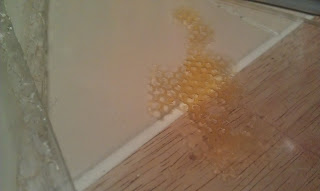The problem happens when the arm (and platform) try to lift the slice up. The printed resin slice is too firmly attached to the glass bottom of the vat, and the resin releases from the build arm platform instead of the vat platform. I've tried roughing up the bottom of the build arm platform for better adhesion, as well as greasing up the glass vat with silicone lubricant. No luck so far.
Other designs I've seen use a mechanism for sliding and/or tilting the build vat. This allows the interface between the resin and the bottom of the vat to release suction before/during the lift sequence.
One problem that I'm facing now is that my vat is fairly large, and I don't have room on the surface of my printer to add in a tilt/slide mechanism easily. The reason my vat is so large is because I didn't modify my projector optics for a shorter throw distance. I suppose the "ideal" throw distance would project the 1024x768 resolution of the projector onto a 102 x 77mm area on the bottom of the vat for a 10 pixels per mm resolution. My projector's minimum throw distance is a little longer, giving me a size of approximately 155 x 120 mm. This is fine by me, however; if I want to add in a tilt mechanism, I may have do one or more of several things:
1) Adjust the projector throw distance to be shorter, so I can have a smaller vat, and more room for a slide/tilt mechanism on my existing machine.
2) Rebuild my machine with a larger top surface for additional space for the tilt/slide
3) Completely rebuild my machine - Now to be fair, I was thinking about doing this anyways. I want to have a smaller design that uses a horizontally mounted projector and a mirror to project the image to the surface of the bottom of the vat.
Well, I should just choose an option and stop stalling so I can get up and printing.
On some good news, several people have reported to me that they've used my software along with their printers to successfully print!
I'm still in the process of adding more functionality to my application. Look for some good new features real soon.
-Steve






